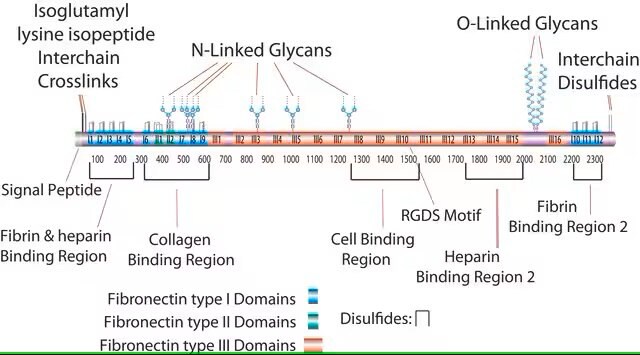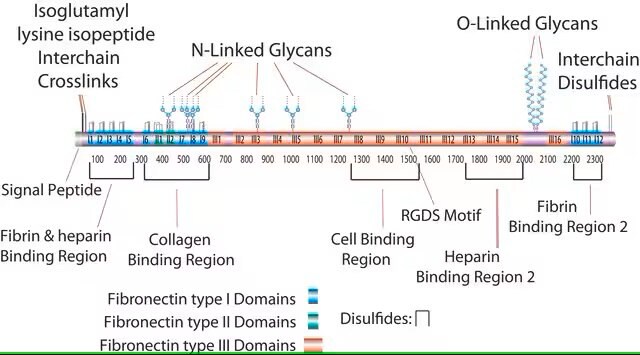We test the coated culture surface by culturing cells. We compare the adherence of the cells to wells that have been coated with media containing BSA (negative) and media containing 10% FBS (positive). The cell growth should be not less than 50% of the positive control and greater than 50% of the negative control.
推薦產品
產品名稱
人血浆纤连蛋白, lyophilized powder, BioReagent, suitable for cell culture
生物源
human plasma
品質等級
無菌
sterile
產品線
BioReagent
化驗
≥85% (SDS-PAGE)
形狀
lyophilized powder
分子量
450 kDa
包裝
pkg of 5 x 5 mg
pkg of 1 mg
pkg of 2 mg
pkg of 5 mg
濃度
>1 mg/mL protein
技術
cell culture | mammalian: suitable
表面覆盖率
1‑5 μg/cm2
雜質
HBSAG, none detected
HCV, none detected
HIV-1/HIV-2, none detected
溶解度
H2O: 1 mg/mL at 37 °C (Store reconstituted solution in working aliquots at -20°C or lower.)
NCBI登錄號
UniProt登錄號
結合特異性
Peptide Source: Collagen
運輸包裝
dry ice
儲存溫度
−20°C
基因資訊
human ... FN1(2335)
尋找類似的產品? 前往 產品比較指南
相關類別
一般說明
應用
生化/生理作用
注意
準備報告
免責聲明
儲存類別代碼
11 - Combustible Solids
水污染物質分類(WGK)
WGK 3
閃點(°F)
Not applicable
閃點(°C)
Not applicable
個人防護裝備
Eyeshields, Gloves, type N95 (US)
從最近期的版本中選擇一個:
分析證明 (COA)
客戶也查看了
文章
纖維連接素 (FN) 在細胞外基質纖維組裝和細胞互作中扮演關鍵角色。
Fibronectin (FN) plays crucial roles in extracellular matrix fibril assembly and cellular interactions.
The extracellular matrix (ECM) and its attachment factor components are discussed in this article in relation to their function in structural biology and their availability for in vitro applications.
The extracellular matrix (ECM) is secreted by cells and surrounds them in tissues.
條款
Dilute fibronectin for cell attachment, varying per cell type. Coating protocol, products, and FAQs provided.
稀釋纖維連接素用於細胞附著,因細胞類型而異。提供塗佈方案、產品及常見問題。
相關內容
Defined culture conditions. Consistent growth of human cancer cell lines in PromoCell’s serum-free/xeno-free Cancer Cell Line Media-XF. Explore over 350 PromoCell products on Sigma.com
定義的培養條件。人類癌症細胞株在 PromoCell 的無血清/無毒素癌症細胞株培養基-XF 中持續生長。在 Sigma.com 探索超過 350 種 PromoCell 產品
-
How do I test the wells/flasks that have been coated with fibronectin?
1 answer-
Helpful?
-
-
How do I determine how much fibronectin is in solution?
1 answer-
As the product may contain undissolved material, the amount of fibronectin in solution can be determined by UV absorbance. The extinction coefficient for a 1% solution (10 mg/ml) is 13.5 at 280 nm.
Helpful?
-
-
What is the procedure for coating culture surfaces with fibronectin?
1 answer-
To coat culture surfaces: 1. Dilute fibronectin in sterile balanced salt solution and coat the culture surface (1-5 μg/cm2) with a minimal volume. 2. Allow to air dry for at least 45 minutes at room temperature. Excess fibronectin may be removed by aspiration, but this is not necessary.
Helpful?
-
-
How do I solubilized Fibronectin?
1 answer-
Dissolve at 1 mg/mL in water. Allow to dissolve for at least 30 minutes at 37 °C. A small amount of undissolved material may remain. This will not affect product performance.
Helpful?
-
-
How do I choose which fibronectin product to use to coat culture surfaces for cell growth?
1 answer-
The species source for the fibronectin used when coating culture surfaces is not important. It is the presence of the RGD binding site that is present in all fibronectins that promotes binding.
Helpful?
-
-
How long can I store fibronectin coated plates, etc?
1 answer-
Fibronectin coated cultureware can be stored for 2-4 weeks at 2-8 °C in a closed sterile container, or in sterile sealable bags.
Helpful?
-
-
What is the difference between Fibronection Products F2006 and F1056?
1 answer-
The difference between Product Nos. F2006 and F1056 is in the purity specifications and endotoxin testing. Product No. F2006 has a purity specification of ≥90% and is not tested for endotoxin contamination. Product No. F1056 has a purity specification of ≥95% and is tested for endotoxin contamination with a specification of ≤100 EU/mg.
Helpful?
-
-
How long can I store the fibronectin solution?
1 answer-
The product is good for at least a year at 2-8 °C if kept sterile.
Helpful?
-
-
What is the Department of Transportation shipping information for this product?
1 answer-
Transportation information can be found in Section 14 of the product's (M)SDS.To access the shipping information for this material, use the link on the product detail page for the product.
Helpful?
-
Active Filters
我們的科學家團隊在所有研究領域都有豐富的經驗,包括生命科學、材料科學、化學合成、色譜、分析等.
聯絡技術服務







